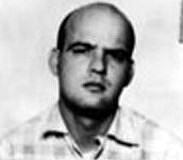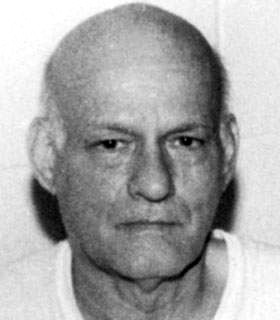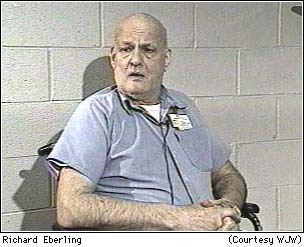Early life
Richard Eberling was born Richard Lenardic in Cleveland, Ohio to Louise Lenardic, an unmarried woman, who identified the baby's father as George Anderson, a Cleveland Heights, Ohio police officer who was also known as an alcoholic. Despite her attempts to keep the baby whom she had named Richard, the child was eventually placed into the Cuyahoga County, Ohio foster care system designated as Ward 1575, where he received the minimum amount care needed to sustain him as he passed from family to family.
On subsequent visits to the Cuyahoga County welfare office, Lenardic herself began to exhibit irregular and eccentric traits. Richard also had behavioral traits that disturbed his foster families including on-going tantrums, compulsive masturbation and an inability to acquire language.
Ultimately Louise Lenardic refused to surrender her rights to her son, meaning that there was no chance for Richard to be adopted into a stable home.
In addition to behavioral problems such as excessive breath holding, an inability to acquire language skills and disassociative tendencies, Richard Lenardic also showed homosexual tendencies at a young age, which coupled with his exhibitionism also caused problems in placing him in private homes, and while housed in county facilities. At one point a potential adoptive home was found, however the family backed out of the adoption after the introduction of another potenially adoptive infant was brought into the home and Richard, age four, begin to mimic the infants behaviors.
In 1939 Lenardic was placed with George and Christine Eberling, an older couple who farmed near Bay Village, Ohio. The Eberling’s housed numerous foster children, using them as cheap labor for the farm. Richard soon became a favorite of Mrs. Eberling, whose fawning attentions fueled his girlish mannerisms. Cuyahoga County case workers noted that Richard refused to play games with other boys, instead preferring to stay inside and clean, "redecorate rooms" and wear clothing belonging to Mrs. Eberling. It was also noted that Richard's mother wanted to establish contact with him, however this posed a problem for Cuyahoga County authorities because he had been told that both of his parents were deceased.
In 1946, while Richard was still with the Eberlings, George Eberling died while suffering from pneumonia, however the official cause of death was listed as a stroke.
Suspect activities
Eventually Richard graduated from high school, established his own house cleaning and decorating company and purchased the Eberling farm from Christine Eberling. In 1948, he legally had his name changed from Richard Lenardic to Richard George Eberling.
However successful Richard Eberling was, he also developed a tendency to steal from his clients while cleaning their houses, usually taking personal items, like jewelry. This resulted in charges being brought against him and convictions for petty thefts. One of clients in the window washing business was Marilyn Sheppard, and Eberling had been at the Sheppard home on the day of her murder washing windows when, according to Eberling he cut himself and required the use of the Sheppard’s house to wash up and stop the bleeding. This also was Eberling's account of how he came into the possession of one of Marilyn Sheppard's rings during one of his petty theft arrests in 1959.
Eberling also positioned himself as an aide to Cleveland Mayor Ralph Perk in the early 1970s through his friendship with the Mayor's wife Lucille. (During her husband's administration, Lucille Perk made national headlines when she and her husband were invited to an event by the Nixon White House which she refused because the event was on the same night as her league bowling night.)
In 1973 Eberling was placed in charge of a committee charged with the remodeling of Cleveland's City Hall, causing a storm of criticism among Cleveland's design community because he lacked the training to do so. A financial crisis emerged as Eberling's spending, and his inability to account for it, landed on the front page of Cleveland Plain Dealer.
In 1974, Eberling's companion, Obie Henderson, became Perk's executive secretary. In 1977 both Henderson and Eberling lost their positions in city hall when Perk was voted out of office.
While hobnobbing in Republican fund raising party circles, Eberling and Henderson met Patricia Bogar at a fund raiser for the Cuyahoga County Auditor George Voinovich. At first, Bogar claimed to have dated Henderson, however whenever Henderson would arrive for a date, he had Eberling in tow. Eventually, Bogar, Eberling and Henderson became friends, with Bogar receiving a her regular guest room at Eberling's home in Westlake.
Relationship with Ethel May Durkin
Eberling also became friends with Ethel May Durkin, a wealthy, childless widow who lived in Lakewood, Ohio who had hired Eberling to do some decorating for her, and quickly became her most trusted confident. This time it was Durkin's death, as well as the deaths of her two sisters that raised suspicions about Eberling.
Durkin's sister, Myrtle Fray, took an instant dislike to Eberling. Fray was also reportedly involved with illegal gambling. Fray was beaten savagely about her head and strangled in her secured apartment building on May 20, 1962, after she had readied herself for bed. More than twenty years later, when questioned about the murder of Fray made statements that corroborated with previously unpublished information in the police report. Eberling also stated that he wouldn't have been surprised if the murderer had washed up in the sink, and then donned one of Fray's dresses to use as an escape costume to avoid being filmed by the lobby security camera. According to author James Neff, thirty years following the death of Myrtle Fray, Eberling wrote that Fray was killed in the same manner as Marilyn Sheppard.
Durkin's elder sister Sarah Belle Farrow died under suspect conditions in March 1970 while living with her sister in Durkin's spacious Lakewood home. This time the death was attributed to injuries sustained in a fall down the basement steps that broke both legs and both arms. Eberling later attributed the accident to "Belle's age" and then stated that if he had wanted to kill her he would have pushed her down the basement stairs. By 1970, Eberling was regularly pulling cash out of Durkin's bank accounts.
Eberling enlisted the help of Patricia Bogar, to help forge documents that would give Eberling complete control over Durkin's finances, with Eberling guessing that estate could be worth in excess of $500,000 dollars, with Bogar to receive ten percent for her part. As Durkin's health declined, Eberling used the documents to make financial and medical care decisions for Durkin. Ethel Durkin also began having a number of accidents that resulted in serious injuries, including falls down flights of stairs. Eberling controlled her prescription regimen, and Durkin was often kept in a sedated state. Bogar, suspecting that Eberling might cheat her out of the promised $50,000 wrote a detailed letter for which she had her signature notarized, and mailed it certified mail to her attorney with instructions on placing the unopened letter in safe keeping until such a time in the future that she might require it back.
Durkin eventually came under the care of Kathy Wagner, a health aide whom Eberling hired, and eventually confided to that slitting a throat and watching someone die was exhilarating, and that he had killed Marilyn Sheppard and assaulted her husband, Dr. Sam Sheppard, in the head with a steel pail, adding "You didn't hear that." (Neff, page 295-298).
On November 15, 1983 the squad was called to Ethel May Durkin's home where the paramedics found she face down on a hardwood floor. Eberling claimed that she had gotten up from her chair and fallen. Eberling told the EMS team that he thought it was a heart attack, but her vital signs, combined with wounds to her face lead medical professions to think she had been attacked. X-rays revealed that Durkin's neck bone had been broken in the same spot where Marilyn Sheppard's had been broken. Durkin died from the injuries on January 3, 1984.
In Durkin's will, which had been forged by Eberling and Bogar (and two other accomplices who were being blackmailed by Eberling for insurance fraud), Durkin left the bulk of her estate to Eberling. Also in the will was the instruction that she was to be buried with her jewelry and clad in her favorite mink coat. Before the casket was sealed, Eberling removed her jewelry and her mink coat.
Jilted by Eberling and Henderson, Bogar began the process of turning on Eberling, reopening the Durkin matter. While Lakewood police moved forward with their investigation, her estate was turned over to local independent attorney by the Cuyahoga County Probate Court for review. Finding irregularities with the estate accounting and signatures, the matter was returned to the court system for additional investigation.
In July 1988 Eberling, Henderson and two others were indicted for forgery, perjury, aggravated grand theft, tempering with evidence and tempering with records. Bogar, who had simply signed a blank sheet of paper was not changed in the matter.
Shortly thereafter Durkin's body was exhumed for examination, and detectives took note that During was without her fur coat and her diamonds. A full autopsy revealed that Durkin was hit hard in the neck from behind. Eberling, who had claimed to have hit Durkin to one of the co-conspirators was charged with murder. Eberling and his companion Obie Henderson were found guilty of the murder of Ethel May Durkin in July 1989; the co-conspirators were convicted and received suspended sentences for their help in testifying against Eberling and Henderson.
Link to Sheppard Case
While in prison, Eberling boasted to a fellow inmate that he had killed Marilyn Sheppard and beaten Sam Sheppard when Sheppard had attempted to stop him. Following that revelation, he also agreed to meet with Samuel Reese Sheppard, Sheppard's son, and disclose information that would be of value to him. Sheppard spoke out publicly on Eberling's possible involvement, setting in motion legal actions which would bring the matter before the courts again.
While in prison, Eberling sent letters to Sam Reese Sheppard, containing references to the crime and promises to reveal all at the right time. Eberling also met with reporters and authors regarding his potential role in the Shepard murder case, during which he seemingly enjoyed the attention being lavished upon him. Eberling had suffered from male pattern baldness, as a young man he owned and wore a bushy appearing hair piece, which Dr. Sheppard mentioned in his trial as part of his defense.
Additional suspected crimes
It was also during this time that Eberling's link to two other suspicious deaths came to light:
-
George Eberling (1946), while being taken care of by Christine Eberling and Richard, it was discovered that he had ingested poison immediately before suffering his stroke, which had been left on his bed side nightstand.
-
Barbara Kinzel (1956), Eberling's purported girlfriend, and a nurse at Sam Sheppard's Bay View Hospital, allegedly died when Eberling veered off a Michigan highway and slammed her Ford convertible into the back of a parked truck. Kinzel, who had cared for Sheppard immediately following the murder of Marilyn Sheppard, claimed that she felt Sam Sheppard was innocent based on the severity of his condition after the incident. After Kinzel's comments had been circulated in newspapers, Richard Eberling began calling on her and the two began to date. Eberling later claimed that following the accident that claimed Kinzel's life, he reached over and found her body crumbled on the floor in front of the passenger seat.
While no autopsy was performed on George Eberling, one was performed on Barbara Kinzel due to questions raised at the accident site. With the convertible top down at the time of the accident, and without there being a seat belt, there was the question on why her body wasn't thrown from the car. Eberling claimed that she had hit the windshield, but noted that there was no bleeding, internal or otherwise, anywhere on her body, nor was their evidence of safety glass found in her facial tissues as would be indicated in a case where an object would strike the windshield with the force that would have occurred in the accident. The coroner did note that her neck was broken along the second vertebra (as were Sheppard's and Durkin's).
Speculations were made that Eberling had killed Kinzel to keep her quiet on Sheppard's innocence should a retrial be ordered. It should be noted that while it was Kinzel's car that was involved in the accident that took her life, Eberling made a healthy financial settlement from the company that owned the truck for his injuries sustained in the case.
While the evidence linking Eberling to these deaths was seemingly evident, no action was taken because of Eberling's death in prison on July 25, 1998, aged 68.
Legal actions that transpired following his death relative to any possible involvement in the murder of Marilyn Sheppard proved inconclusive.



